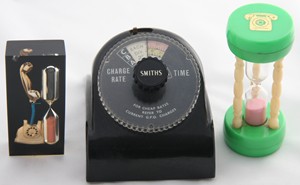Vintage telephone timers

How long do you spend on the phone? Today people will chat away for hours. In the 1960s every minute was precious.
Counting the cost of telephone calls became important in the early 1960s. It was down to something called 'Subscriber Trunk Dialling' or STD.
In the old days you could only dial local numbers yourself. For longer distances, or 'trunk calls', you had to call the operator and ask her (as it usually was) to dial the number for you. Whether local or trunk call, you got warning pips after each three-minute period, so you knew how long the call was.
With STD, you could dial long distance calls yourself. But as STD rolled out across the country, they abolished the pips. Suddenly there was panic about how much phone calls were going to cost.
According to Roy Blackman writing in the Daily Mirror, husbands were worried about their chatterbox wives. They rushed to the shops to buy devices to count the cost of the calls. [1]
One device was an egg-timer fixed to a model of a vintage looking phone. There were many other egg-timers for the telephone on the market. The 'Fone-Tymer' had a wooden stand printed with an old-fashioned reminder that 'Time is money'.
There were more complex devices. The most sophisticated was a clockwork timer from Smiths that worked out the cost in shillings and pence. Another combined a phone dialler (if you did not want to user your fingers) with a timer.
In 1961 you could get the following devices:
- Smiths Telephone Timer (clockwork) - £1 17s 9d
- Venn-O-Phone clockwork timer - £1 10s
- Fone-Tymer ('Time is Money') - egg timer style - 7s 6d
- HD 139 (egg timer style) - 14s
- Newmark Fonetimer (combined dialler and timer) - £1 17s 6d
Source: 'Telephone Timers' published in Which? by the Consumers' Association, December 1961, page 335.
Another clever device was the 'Telephone Time Check' made in Coventry. The 'Telephone Time Check' attached to the base of the telephone. A warning light came on after a pre-set amount of time. [2]
How much did you get for your money?
Under STD calls were charged in 2d units. The amount of time you got for your 2d depended on where you were calling.
In 1961 charges were:
| Distance | Peak | Off-peak |
|---|---|---|
| Local | 3 minutes | 12 minutes |
| <35 miles | 30 seconds | 45 seconds |
| 35-50 miles | 20 seconds | 30 seconds |
| >50 miles | 12 seconds | 18 seconds |
Off-peak was 6pm to 6am weekdays and Saturday, plus all day Sunday.
Source: 'Telephone Timers' published in Which? by the Consumers' Association, December 1961, page 334.
2d in 1961 was about 13p today. It doesn't sound a fortune, but a one-hour peak time call 50 miles away would cost £40 in today's money. At the other end of the scale, an off-peak local call would cost 70p (in today's money).
Time on the phone mattered. It still does today. Many 'unlimited' packages limit free calls to one hour in duration.
By Steven Braggs, January 2022
References
[1] 'Sands of time' by Roy Blackman, published in the Daily Mirror, 21 October 1961, page 15
[2] 'Keeping tabs on time' by Colin Byrne, published in the Daily Mirror, 9 May 1962, page 6


Comments